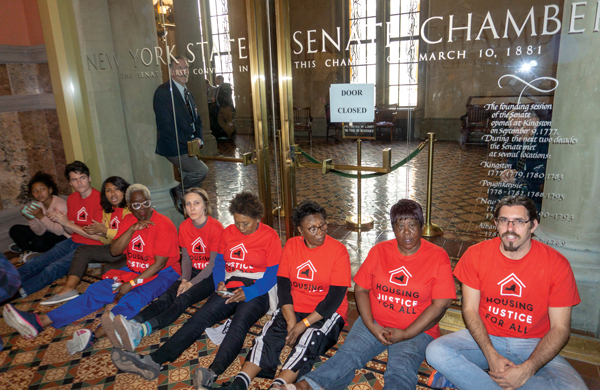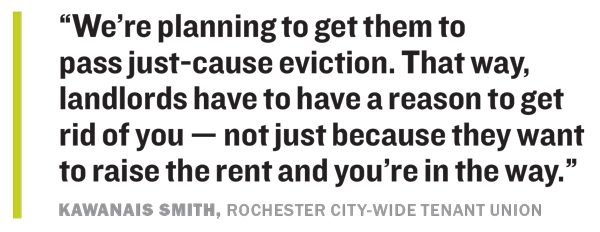 When Marcus & Millichap’s Charles “Chip” Collins listed a 97-unit Schenectady rental property for just over $10 million in June, he said, he was shocked by the number of investors “banging down the doors” looking for a deal.
When Marcus & Millichap’s Charles “Chip” Collins listed a 97-unit Schenectady rental property for just over $10 million in June, he said, he was shocked by the number of investors “banging down the doors” looking for a deal.
While Schenectady is more than 130 miles from the South Bronx — which has become a hotbed for multifamily buyers in recent years — the blue-collar upstate city is one of a handful seeing new levels of investor interest.
For landlords looking outside the box for returns, the market in upstate New York is becoming increasingly attractive. And a growing number of real estate firms traditionally focused on the five boroughs and New Jersey’s urban cores are searching above and beyond the Hudson Valley.
Many, including Stephen Ross’ Related Companies, Fairstead Capital, Centurion Real Estate Partners and Carnegie Management, are chasing higher capitalization rates, looser rent regulations and large, distressed assets, industry sources told The Real Deal.
“In New York City, cap rates are being compressed and the returns investors are getting are almost nothing in some cases,” said Collins, who focuses on the upstate New York market and declined to name specific firms. “At the end of the day, what they’re promising their investors is appreciation. So they’re going farther out of the metro area, looking at secondary and tertiary markets. They’re going upstate.”
That’s exacerbated, of course, by New York’s new rent laws, which have put a damper on owners of rent-stabilized units in the city. For landlords in the Garden State, meanwhile, stringent rent laws have been on the books since 1974.
Related, for example, plans to lay down $23.5 million to acquire and renovate the moderate- to low-income Marina Vista Apartments in Buffalo, according to Erie County records, while multiple sources say the New York real estate giant is looking to snap up more units in Syracuse and Rochester. Related declined to comment.
“We’re on the cusp of it,” said Brian Whitmer, Cushman & Wakefield’s director of capital markets in New Jersey, who’s negotiating the sale of a multifamily complex formerly owned by indicted developer Bob Morgan. “We’ve absolutely seen capital looking outside the NYC metro market.”
But some landlords may be in for an uphill battle. The new state laws can make it harder for landlords to carry out evictions across the board, and tenants — fresh off their legislative triumph — are urging local officials to opt in to rent regulation in several upstate cities.
And while some multifamily firms, like Irving Langer’s E&M, were ahead of the pack, others are waiting to see how the new statewide regulations will affect areas outside of the five boroughs.
 Jay Martin, of the landlord lobbying group Community Housing Improvement Program, told TRD in June that fending off municipalities’ attempts to opt in to rent regulation would be his group’s top priority. Yet progress has been slow going, he noted in August.
Jay Martin, of the landlord lobbying group Community Housing Improvement Program, told TRD in June that fending off municipalities’ attempts to opt in to rent regulation would be his group’s top priority. Yet progress has been slow going, he noted in August.
“I can tell you 100 percent, our members aren’t looking to expand into Rochester,” Martin said in a statement.
The rental rush
Nob Hill, a Syracuse garden apartment complex that traded for nearly $60 million last year, raised eyebrows as it set a multifamily record for Central New York.
Now, for those on the hunt for new opportunities, it’s increasingly becoming a game of chicken.
Since June 14, when Gov. Andrew Cuomo signed the state’s stringent new rent laws curbing everything from vacancy decontrol to capital improvements and several-month security deposits, industry observers have seen a notable uptick in downstate investors eyeing large upstate rental portfolios — especially in Syracuse and Rochester.
“The number of investors [upstate] has gone up by 20 to 30 percent since the rent laws, with names that we have traditionally not seen out of Manhattan and the boroughs,” Whitmer said.
Some of those investors, including E&M, have been snapping up bits and pieces of Morgan’s nationwide portfolio after the SEC alleged “Ponzi scheme-like” activity and mezzanine lender SteepRock Capital foreclosed on several properties in the 55,000-unit portfolio.
The Manhattan-based real estate investment firm Rockport Equity is now in talks for Brookwood on the Green, a sprawling 340-unit apartment complex in Liverpool near Syracuse, a representative for Rockport confirmed to TRD. The U.S. attorney general’s office named the Brookwood complex in a May indictment citing a “multimillion-dollar mortgage fraud scheme.” The property last traded for $14.8 million in 2013, and Cushman’s Whitmer is marketing the asset this time around for an undisclosed price.
John Clark, president of Cushman subsidiary Pyramid Brokerage in Syracuse, pointed to dwindling returns in the New York City metropolitan area prompting investors to look upstate.
“We’re seeing some instances [in the city] where cap rates are in the low 6’s, and others near 8 percent,” Clark said. “How the rent laws will change things in each of these markets upstate remains to be seen.”
A representative from Centurion said areas like Albany, Troy and Schenectady are attractive because “the market is pretty good and there’s no rent regulation” but declined to comment further.
“I know some upstate owners as well who are saying people are definitely expanding beyond the city,” said B6 Real Estate Advisors CEO and former New York City mayoral candidate Paul Massey, who noted that there’s “less complexity and less regulations upstate.”
“And why wouldn’t they look for opportunities to invest?” Massey added. “If they know how to asset-manage, they’ll put their talents to work in places outside of the city.”
Out of the frying pan?
Most of the changes to the state’s rent laws affect tenants and landlords in the five boroughs and municipalities in Nassau, Westchester and Rockland counties, according to state legislative records. In New York City, the new laws were applied to more than 1 million stabilized apartments overnight.

But while the real estate industry escaped even more radical reforms, recent changes that have gotten less attention in the city are already starting to reshape some of the markets investors are now targeting.
One change allows municipalities to opt in to rent stabilization if the vacancy rate is below 5 percent. And, on top of new restrictions on the kind of information landlords can use to deny lease applications, all landlords in the state of New York must now give two weeks’ instead of three days’ notice for evictions.
When Daniel Stein of New Jersey-based Stein Capital bought a 132-unit multifamily garden complex on the outskirts of Rochester in February, Garden State-style rent regulations were just what he thought he was escaping.
“New Jersey is very tenant-friendly. It takes a hell of a lot longer to get them out,” he said. “One of the advantages we saw when we first bought was that we could get tenants out quicker if they weren’t paying or they were breaking their lease. You put in a three-day notice, you get a court order, you get an eviction. We saw that as an advantage.”
Despite concerns about changes to the eviction process and the potential spread of rent regulation, Stein said his firm is looking to acquire more multifamily properties in both Syracuse and Rochester, where he’s “keeping his eyes open.”
John Nacca, an attorney in Rochester whose firm boasts 3,500 processed evictions a year, said that the changes to the waiting period for eviction notices are causing landlords to send out nonpayment notices earlier, to be on the safe side.
“It’s like throwing the baby out with the bathwater,” Nacca said. “A lot of good-intentioned tenants who had an issue and they couldn’t do it on the fifth. Well, guess what, evictions are starting on the fifth.”
Even with the stricter regulations, Rochester is still much more permissive than New York City for now, and multifamily players are looking to get more bang for their buck. In some cases, landlords are upgrading kitchens and installing new vanities to bump up rents by $100 a month or more, seeking returns as high as 12 percent, according to Collins.
But while investors hunt for value-add deals upwards of $25 million upstate, tenants are already organizing and making renewed demands for rent stabilization and stricter eviction laws in Rochester, Schenectady and Kingston.
“We’re planning to get them to pass just-cause eviction,” said Kawanais Smith of the Rochester City-Wide Tenant Union, which is working on a campaign to sway lawmakers to opt in to rent stabilization. “That way, landlords have to have a reason to get rid of you — not just because they want to raise the rent and you’re in the way.”
The tenant group, now part of the Upstate/Downstate Housing Alliance, formed in 2017 after a dispute over conditions in a rental complex owned by landlord Peter Hungerford culminated in residents organizing a series of building-wide rent strikes across Hungerford’s Rochester portfolio.
Pictures of icicles inside the landlord’s 17-story Southview Towers shamed public officials into emergency action, and repairs were quickly made.
That victory inspired other tenant groups, including residents of Hungerford’s 447 Thurston Road. Calls for a building-wide rent strike got the attention of local media and officials, and after a judge made personal visits, four of Hungerford’s 17 buildings were turned over to a receivership with Rochester-based Home Leasing.
The new owners began renovating more than 60 apartments in late July, with $10 million in funding promised by Cuomo. The groundbreaking ceremony was attended by Homes and Community Renewal Commissioner RuthAnne Visnauskas and representatives from the governor’s office.

Kawanais Smith (center) and other tenant activists at the New York State Capitol in June
But some tenants show no signs of stopping with repairs and concessions from individual landlords: They’re out for systemic change.
“If we had rent stabilization and if we had ‘good cause,’ none of this would happen,” said Ryan Acuff, a community organizer who’s also a member of the Rochester tenant group. Acuff said his colleagues are focused on educating local officials about rent stabilization so they can opt in without delay.
Class actions
Schenectady — a city of about 65,000 where General Electric once employed 45,000 workers — had a reputation for being a strong union town.
Now the local GE plant employs roughly 4,000 people, and former Union College President Roger Hull told the Times Union last year the abandoned factory and office facilities are a “prime piece of real estate.”
But a resurgence of class politics is playing out in the once-thriving manufacturing town.
GE union workers, including Schenectady’s Local 301, threatened a nationwide strike in July for the first time since 1969, while a City Council member joined with other tenant advocates across the state to demand rent regulation and a local landlord has organized a task force to fight back.
“Because landlords have the ability to raise rents without any kind of regulation, we really need to take a look at that,” Schenectady Council member Marion Porterfield told TRD. “Some [tenants] are being priced out of apartments. My goal is to try to opt in. We are gathering resources to move forward.”
The first step to opt in to rent stabilization is to issue a request for proposals for a vacancy survey, as Kingston has, Porterfield noted.
Chris Morris, a Schenectady landlord and president of Schenectady Landlords Influencing Change, has a different vision for the future, though, and she’s not alone.
Morris said SLIC is part neighborhood association, part trade group and organizes events for the local real estate industry. One presentation organized by SLIC in May drew more than 70 landlords, investors and brokers.
Morris said she was horrified by the new rent laws, which were hand-delivered in a letter when a friend stopped by her home in Schenectady after Cuomo signed the legislation.
“To have legislation come out and change the rules from one day to the next is ludicrous,” said Morris, who argued that the new rent laws were “rammed down the real estate industry’s throat.”
“I think the effort to protect the tenant may do just the opposite, because there will be less availability in the older multifamily housing,” she added.
Morris, frustrated that landlords weren’t able to combat the legislative changes before June, formed her task force, which now has the support of local state Sen. James Tedisco and Assembly member Angelo Santabarbara, she said.

SLIC’s ranks of discontented local landlords has swelled to about 25 members, and their first priority is a media blitz, according to the group.
Morris said she understands the intention behind the changes to the laws, but described some tenants as “undesirables” who “wear sneakers, smoke cigarettes and hang out in the street with their cell phones.”
“They sure aren’t working,” said Morris, who voiced frustration that her toolkit for evicting such tenants has been significantly limited.
While the changes to the rent laws clearly cut into SLIC members’ bottom lines, tenant advocates have long bemoaned the impact of evictions on specific demographics. A July study from the Fiscal Policy Institute, a nonpartisan research institute that recommended the consideration of statewide rent regulation, for example, found that families of color are particularly rent-burdened in upstate New York.
Meanwhile, the divide is growing between lawmakers and community members who advocate for socialist policies and progressive reforms. And with the business community reeling from the latest changes as it struggles to find allies in the new political regime, some investors are pausing to rethink their strategies.
For Time Equities’ Francis Greenburger — who largely built his business on converting rental apartments to condominiums — the risk of upstate municipalities opting in to rent stabilization is too great.
“It’s an irrational loaded gun sitting there,” Greenburger noted. “I was recently offered a deal in upstate New York that we might have considered, and I said, ‘No.’ The city obviously has decided [to expand rent regulation], but other communities will now have to decide.”
